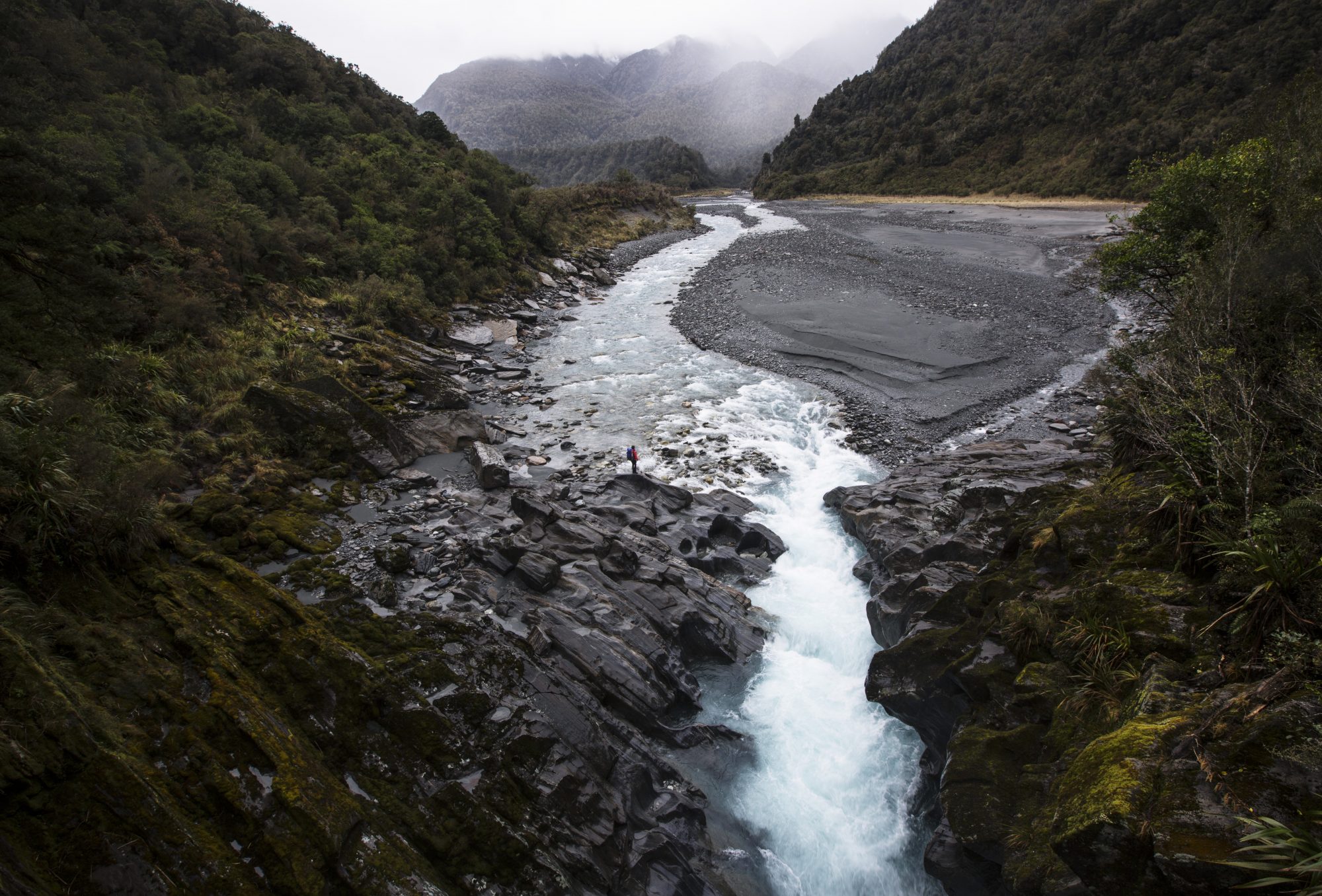
A tale of two currents
Morgan Gorge, a spectacular chasm on the South Island’s West Coast, is a showpiece of whitewater power. Although it has been paddled by fewer than a dozen people, it is the aspiration of kayakers here and around the world to tackle its supreme challenge. If the Minister of Conservation grants a concession to electricity company Westpower to build a hydro-generation scheme on the Waitaha River—as she says she intends to do—Morgan Gorge will become an emaciated trickle for much of the year. Opponents say this would be an environmental tragedy and a cultural loss, tantamount to building a windfarm on the summit of Aoraki/Mt Cook.

Daylight was fading as I stepped back into the forest. It had been a sparkling spring afternoon for the four-hour slog up the Waitaha River from the road-end, 40 kilometres south of Hokitika. I came to Kiwi Flat, a broad shingle clearing carved by floodwaters and blocked by narrow-throated Morgan Gorge. There I dropped my pack and set out for where—according to the map—one of the Waitaha’s tributaries intersected with the gorge. I wanted to get as close as I could to this place of wildness and power, now being weighed in the political balance for a hydro scheme.
There wasn’t much of a trail. An occasional scrap of tattered ribbon tied to a tree branch, or a mouldy square of venetian-blind slat with a nail through it—the classic New Zealand track marker—showed I was heading roughly in the right direction, but treefalls and regrowth had mostly obliterated what was once the main track to Kiwi Flat, now moved to the other side of the river.
Forty minutes later, I was at Anson Stream, picking my way down a staircase of rocks, then climbing on to a boulder as big as a caravan, moss covered and sloping downwards to the abyss.

I stepped gingerly to the edge and looked down. The Victorians used to call this sort of vista sublime, filling the viewer with equal parts ecstasy and terror. The river, cornflower blue and opaque with snowmelt, sluiced through ramparts of charcoal-coloured schist, polished and sculpted up to a floodline several metres above water level. Above that, the rock was clad with a khaki mantle of moss, then a drapery of fern, then luxuriant forest. I sucked in the splendour of it all with a kind of religious hunger, exulting in the raw energy of the place.

I closed my eyes and listened to the roar of the torrent, then imagined that voice silenced. Westpower, an electricity distribution company on the West Coast with aspirations to generate local power, has applied for a concession to divert water from the head of the Morgan Gorge, run it through a tunnel and a powerhouse, then return it to the river 2.6 kilometres downstream.
In engineering parlance, the gorge would be “dewatered”. In plain language, it would be drained dry—or close to it. A remnant trickle (10 per cent of the river’s mean flow) would provide life support for aquatic creatures. The only time the gorge’s elemental grandeur would be revived would be during floods, when water surplus to that captured by the scheme would overflow the intake weir and surge back into the ravine.
[Chapter Break]
Hydroelectricity is generally seen as a public good. It’s environmentally clean to produce, uses a renewable energy source and has a low carbon footprint. The country’s economy was built on the spinning turbines of its powerhouses—one current converted into another—and today around 50 per cent of total generation still comes from hydro.
But in a 2012 report entitled “Hydro-electricity or Wild Rivers”, the Parliamentary Commissioner for the Environment, Jan Wright, noted that less than one per cent of the world’s rivers remain in their natural state, and that such rivers in New Zealand—rivers like the Waitaha—are becoming increasingly scarce. In choosing between hydroelectricity and wild unmodified rivers, the commissioner wrote: “I have concluded that we need to pay more attention to the protection of rivers.”
Why, then, is another wild river on the political chopping block? Why now, when public concern over the parlous state of the country’s rivers, lakes and aquifers is intensifying?
Where is the protection the environment commissioner talked about—especially for a river on public conservation land with statutory provisions in place to preserve its natural features?
The commissioner’s report was triggered by a previous proposal to exploit a wild river: Mokihinui, also on the West Coast, also on conservation land. In retrospect, it seems madness to think that the modification proposed for that river—an 85-metre-high dam creating a 14-kilometre-long lake—might have been permitted by conservation
decisionmakers. We will never know if it would have been. In 2012, just as an appeal over the granting of resource consents was about to be heard by the Environment Court, Meridian Energy terminated the project, citing economic costs and political risks.

The fundamentals of river conservation—seemingly sturdy protections on paper but weak in practice—haven’t changed since then. And the Waitaha proposal tests them once again. Although Westpower’s scheme doesn’t include a dam—it is a “run-of-river” generation project—it is proposed for a place of jaw-dropping magnificence, the sort of place that the Conservation Act was created to protect from industrial development.
Under the act, the type of land that the Waitaha River flows through—stewardship land, which makes up a third of all public conservation land—is required to be managed so that its natural and historic resources are protected. That seems a fairly clear-cut directive. But there is a widespread perception that such land enjoys a lower level of protection than areas with more specific purposes such as national parks or wilderness areas. That perception is routinely exploited by developers, who like to point out (as Westpower does) that their scheme is not proposed for “one of New Zealand’s highest-rated conservation areas”.
In part, the perception of weak protection has arisen because stewardship land, unlike any other part of the conservation estate, can be swapped for private land if the result is considered to be a net conservation gain. Such a swap was envisaged for Mokihinui and, most recently, Ruataniwha, until, in the latter case, the Court of Appeal found an illegality in the process and stopped it.
The land-swap provision has been interpreted to suggest that stewardship land is, as the parliamentary commissioner put it, “open for business”. Certainly, there is no intrinsic impediment to doing business on conservation land—thousands of Department of Conservation concessions attest to that fact—but the crucial test is whether the statutory provisions of the land are upheld. In the Conservation Act, those provisions are stated to be the “preservation and protection of natural and historic resources for the purpose of maintaining their intrinsic values, providing for their appreciation and recreational enjoyment by the public, and safeguarding the options of future generations”.
But the act also provides for consideration of what the effects might be if an activity were allowed that, on the face of it, did not appear to protect or preserve the land in question. And in practice, that consideration comes to dominate the discussion. In the case of the Waitaha, DOC’s 190-page report to its minister is largely concerned with how the adverse effects of the project might be mitigated were it to go ahead.
There is something cumulatively Kafka-esque in reading hundreds of paragraphs outlining such minutiae as how bats are to be treated if discovered during the felling of trees, or native fish are to be facilitated in getting over the weir that is proposed to be built at the head of the gorge (while simultaneously keeping eels and trout from doing so), or the merits of using a paint colour called “Ironsand” to help the industrial structures blend into their surroundings… while the wording of the legislation that seeks to protect and maintain the land “in its current state” gets lost in the rhetorical fog.
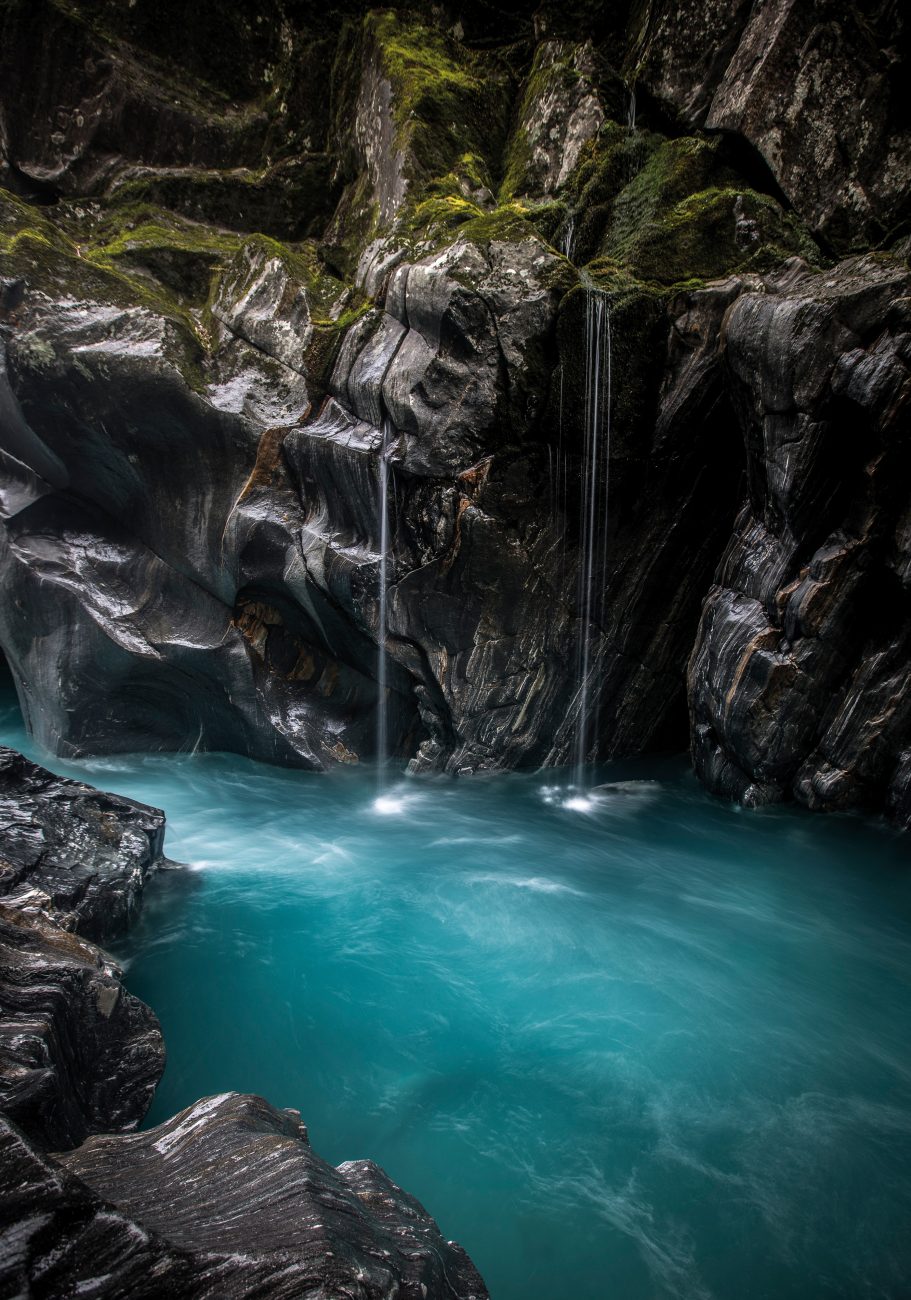
Even the intrinsic qualities of the gorge are parsed and rationalised. Reports from the landscape consultants commissioned by Westpower and DOC agree that Morgan Gorge qualifies as an outstanding natural feature, within the broader outstanding natural landscape of the upper Waitaha catchment, on account of its “exceptional biophysical and perceptual values”. Deliberation then centres on how much modification an outstanding feature can stand before it loses its “outstandingness”.
At issue is whether installing industrial structures at the entrance to Morgan Gorge necessarily reduces the outstandingness of the gorge itself. Perhaps it doesn’t. Would a shipping container dropped on your driveway necessarily diminish your enjoyment of the flowers in your garden?
On this and multiple other issues, the key question, pounding like a drumbeat through the report, is whether there are “adequate or reasonable methods for mitigating [the] adverse effects”.
How do you mitigate the draining of a gorge? Kayakers—the group that stands to lose the most from the abstraction of water from Morgan Gorge—say you can’t, and Whitewater New Zealand, the national body that represents recreational canoers and kayakers, has emerged as one of the scheme’s strongest opponents.
I asked Doug Rankin, Whitewater New Zealand’s conservation officer, why his organisation had gone all-out on Waitaha, pressing its case with DOC, advocating on social media, writing lengthy reports on the impact of the scheme on whitewater values, and working with an expert on the electricity industry to critique Westpower’s proposal.
“The best of the best should be looked after for the public,” he said.
“Morgan Gorge is the best of the best. It will only be paddled by the extreme few, but it can be the aspiration of many. It is a special place, and special places are what make New Zealand great.”
Westpower, for its part, is dismissive of the importance of recreation, suggesting in its concession application that kayakers, trampers and hunters have plenty of other places where they can pursue their interests. The company claims that recreation is “not a natural or historic resource, as defined in the act”, but this is misleading. Recreational use is included as a component of the natural and historic resources that the Conservation Act requires to be protected.
The act also spells out that one of the functions of DOC is “to foster the use of natural and historic resources for recreation”. By contrast, the department has no obligation to facilitate industrial development on conservation land. Whereas the latter may be allowed, the former must be encouraged—and preserved.
[Chapter Break]
How do you even paddle a gorge like the Morgan—a tongue of blue flame scorching through a rip in the earth? How do you face such liquid fire?
I once kayaked over a five-metre waterfall, summoning the courage to move from a safe eddy into the main river flow, feeling the grip of the current, paddling hard out over the lip to clear the rocks below, airborne for a few seconds, then the bone-jolting smack of hull on water. But when I stood at the entrance to Morgan Gorge, I knew with certainty that the only way I would exit that maelstrom was as a corpse.
“The objective danger is huge,” agreed kayaker, climber, adventurer, New Zealand Geographic contributor and now polar expedition leader Graham Charles when I called him to ask about the Morgan. Charles wrote the definitive book on New Zealand white-water, and took part in the first attempt to paddle Morgan Gorge in 2002.
How did he prepare for a descent in such prohibitive terrain? “We spent days with abseil ropes and harnesses, scoping it out,” he said. “The rule is, you don’t run an overhanging gorge like the Morgan without a plan to get out.”
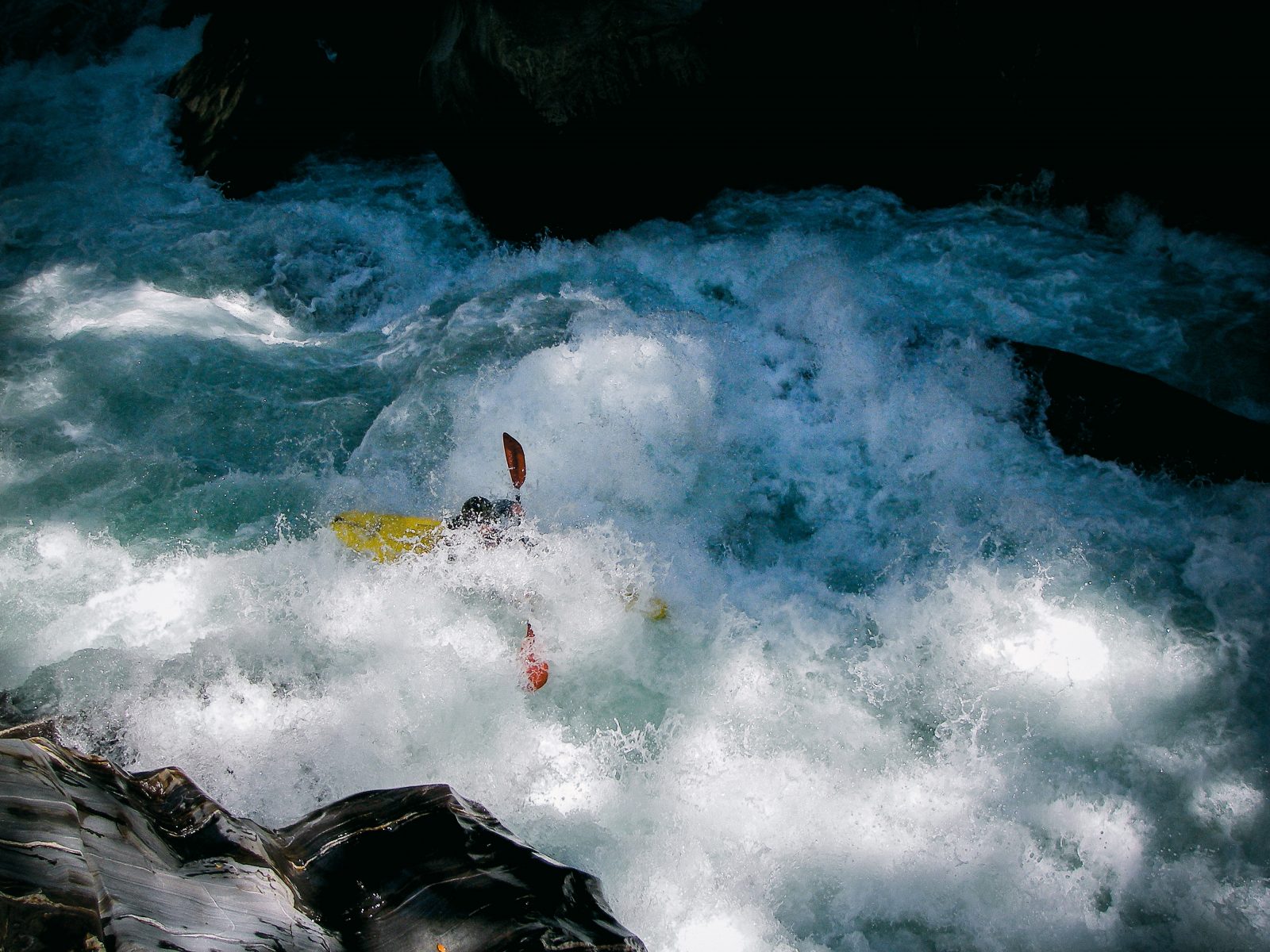
Kayakers recognise six classes of white-water; the higher the number, the wilder the ride. The upper Waitaha, including Morgan Gorge, is mostly Class V, also known as “extreme”. Class V rapids are not the sort of places where you can say over a beer afterwards, “We took a spanking and had to swim”, Charles said. He calls such reaches “high consequence”—another way of saying, “If you get it wrong, you might not come out alive.”
Class VI used to be reserved for impossible reaches—stretches of whitewater where an attempted passage would likely prove fatal. But as the sport has evolved, what was formerly considered impossible is now achievable by the top echelon of paddlers. Changes in boat design and hull shape have radically expanded these kayakers’ horizons. Modern kayaks aren’t much bigger than the person paddling them. They are light enough that you can strap them to your back and tramp in to the tributary you want to paddle—or portage out if the run goes pear-shaped.
Kayakers now use climbing equipment and techniques, too. “You can put a piece of gear into a wall, clip yourself in and stand up to have a look downstream,” Charles said. As a rule, you don’t paddle into a reach where you can’t see the next point of safety.
He recalled the Morgan attempt. “We had a strong team and good flow, but we got to an eight-foot drop and couldn’t see what was at the bottom of it. Up ahead was a death sieve [a jumble of boulders where the main flow funnels into a hole that would trap a kayaker irretrievably]. No one was prepared to run blind over that drop.”
There was no way to retreat upstream and no way to portage around the rapid, so the team tied their boats to the rocks and used their climbing skills to scale the vertical moss-covered bluffs to safety. It took them seven hours to reach the Waitaha road-end. Retrieving the kayaks the next day—abseiling in and hoisting them out—was a nine-hour round trip. The gorge was not successfully paddled until 2010.
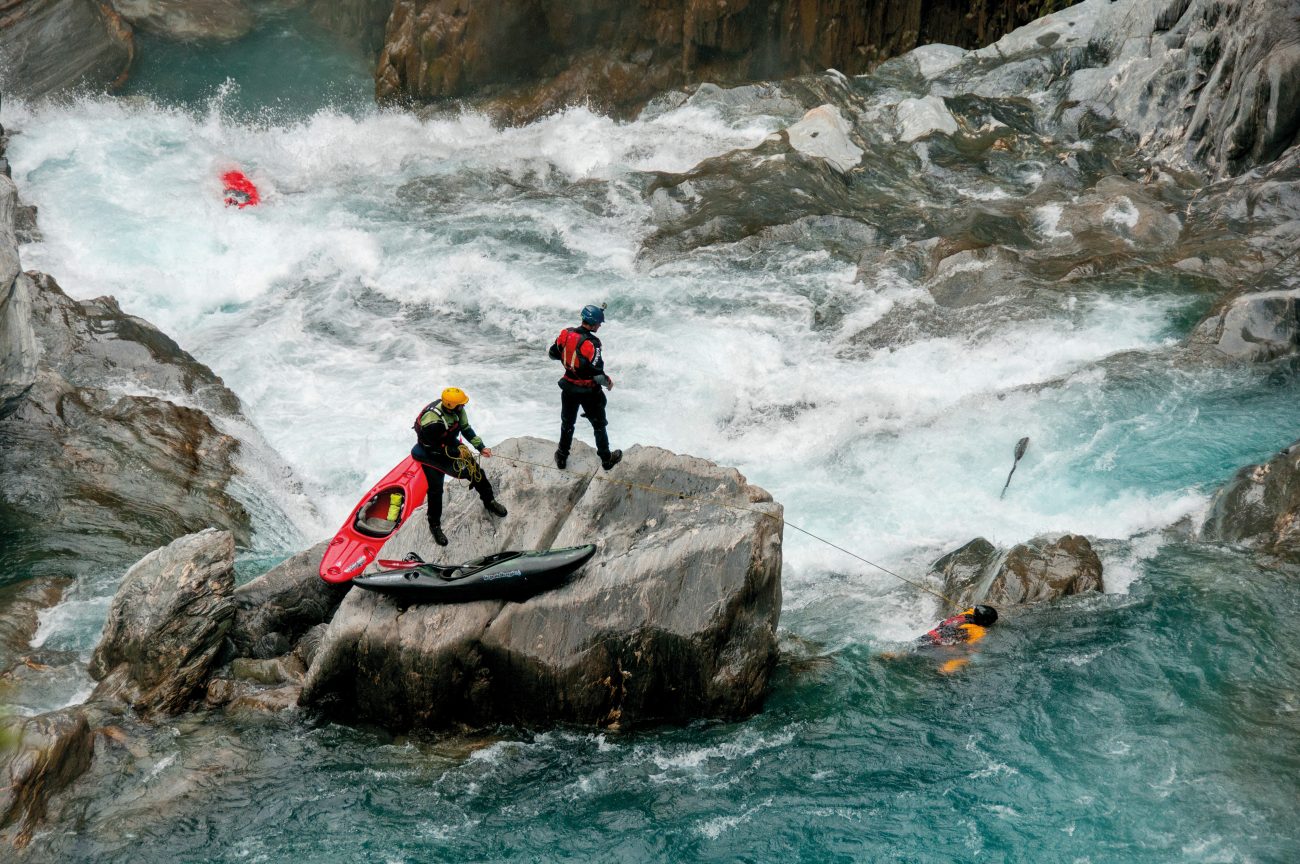
About 10 kilometres upstream from Morgan Gorge is Windhover Gorge, rated V+ to VI on account of its large waterfalls and extreme gradient. In 2013, Justin Venable was part of a team who made the first descent of this ultra-extreme reach.
Venable is one of the few people to have paddled all the gorges and whitewater reaches on the Waitaha, from its headwaters below Ivory Lake, in the Southern Alps, to where it fans out from a single sluice to a network of braids in the broad farmland of the Waitaha Valley. I met him in Queenstown for coffee near the Lakes District Hospital, where he works as a doctor. He had a long shift coming up, so he ordered two cups.
A whitewater run is like a mathematical problem, he told me. “You have to break it down to its simplest elements or it’s overwhelming.” I was struck by the similarity with mountaineering—a climber deconstructs a face into a series of pitches, each with its own requirements of gear, rope and moves. Venable told me there might be as many as 30 individual manoeuvres in paddling a reach like the Morgan. Each starts and finishes from a patch of safe water behind a rock or other obstacle. Even on a Class V rapid there are micro-eddies—points of refuge, he said. You move from one micro-eddy to the next.
Flow is critical. With each additional cumec (cubic metre per second) of water flowing through the gorge, the river level changes. Features open up or disappear, creating opportunities for passage or shutting them down. A river is an endlessly dynamic entity. Heraclitus’s famous statement that you cannot step into the same river twice is emphatically true for whitewater.
I asked Venable about coping with fear in such a descent. “These runs are super-powerful and intimidating, so the trick is to stay as clinical and unemotive as possible,” he said. “But there’s also an element of surrender when you commit to a run, and once you’ve done that it becomes easier.”
It was the lure of rivers like the Waitaha that brought him to New Zealand from his native Louisiana. He came for six months and decided this was where he wanted to live. He and his wife have a six-month-old boy, named for a desert and a mountain: Gobi Tutoko. Last winter, they took him for his first taste of the ski slopes.
“We’re making a conscious decision to pass on wilderness values to him,” Venable said. “Protecting wilderness takes sacrifice. If people don’t develop an intimate connection with the outdoors by a critical age, they won’t be willing to make that sacrifice. We’re making sure he gets that connection.”
For kayakers like Venable, it is the diminishment of wilderness that is the main reason for opposing Westpower’s plans for hydro on the Waitaha—not merely the loss of a kayaking opportunity. Although most of the river would be unaffected by the scheme, the loss of the final reach would mar the experience of the whole—like tearing the last chapter out of a thriller.
The Parliamentary Commissioner for the Environment came to a similar conclusion. “The core value of a wild and scenic river lies in its relatively untouched state, in its character and integrity,” Wright wrote. “Rivers that flow all the way unimpeded from the mountains to the sea are becoming rare. The spiritual significance of a river…rests in the river as a whole.”
[Chapter Break]
According to the Conservation Act, the core or intrinsic values of rivers are a relevant concern when the minister considers whether to grant a concession. Surprisingly, economic values are not. ‘Surprisingly’, because economic matters are assumed to be salient whenever developments on conservation land are proposed. The idea of balancing environmental costs against economic benefits is hard-wired into the nation’s minds.
Westpower’s 222-page concession application is peppered with references to economic benefits. But given the current state of the electricity market—flat demand, low wholesale electricity prices nationally and declining demand on the West Coast in the wake of industrial closures and weak dairy prices—I was curious about Westpower’s economic rationale for the Waitaha scheme. So I called in to its premises on the main street of Greymouth on my way to the river.
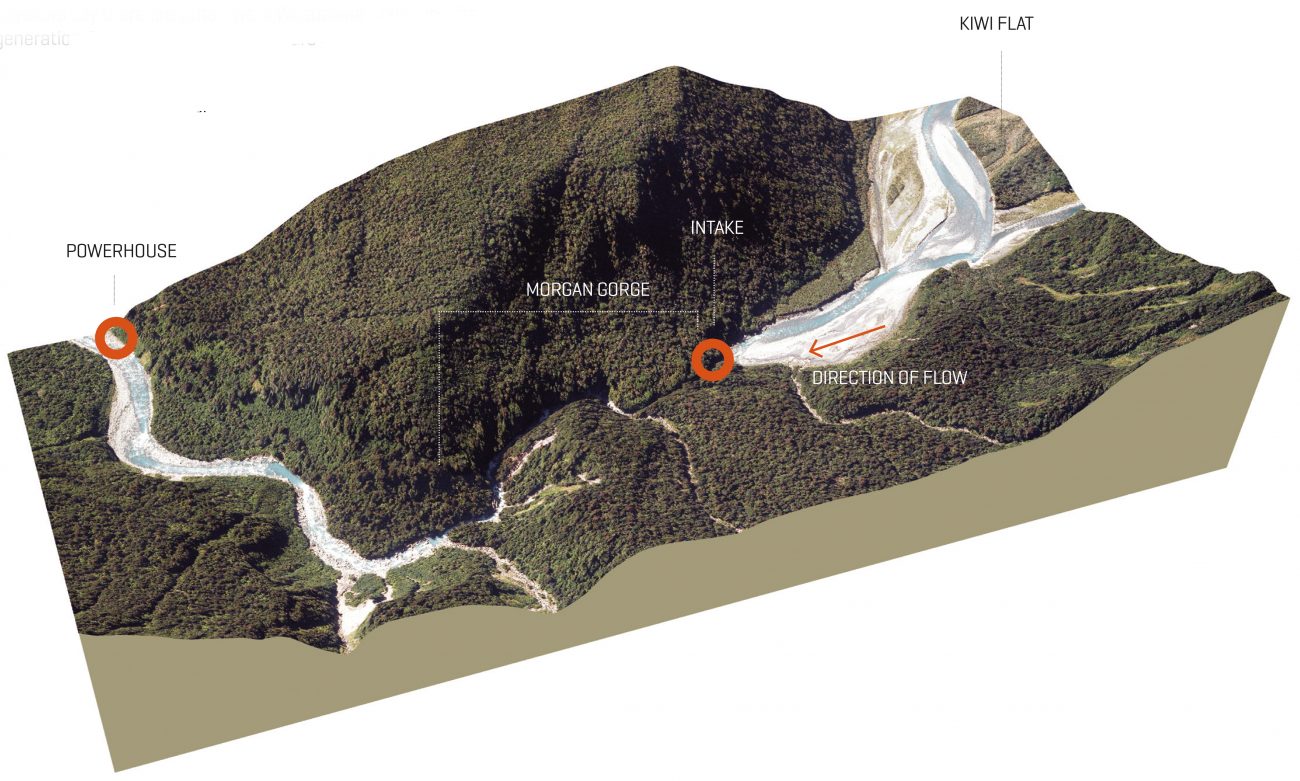
CEO Rob Caldwell ushered me in to his office, but when I asked him to summarise the business case for me, he seemed taken aback. He told me that all the relevant information was on the website. Besides, he said, the company wasn’t talking to the media while the concession process was under way. So that was that. I thanked him for his time and headed south.
Later, I read Westpower’s information cache, plus an assessment of the scheme by Tony Baldwin, a Wellington-based commercial lawyer, consultant and, in the 1990s, a policy adviser to the Cabinet over the restructuring of the Electricity Corporation.
In its concession application, Westpower makes much of the need for “security of supply”, and dairy farmers I spoke to in the Waitaha Valley brought this up as the main reason for supporting the scheme. The Coast gets the bulk of its electricity from outside the region, delivered on transmission lines from the north through Īnangahua or across the Main Divide from Lake Coleridge. Westpower says the length and exposure of the transmission corridors make the Coast vulnerable to interruption of supply. Yet this argument is significantly undermined by the fact that in 2011, Transpower, the owner and operator of the national grid, completed a major upgrade of the transmission network feeding the West Coast that as well as improving its reliability also effectively doubled its capacity. Westpower acknowledged this reality in a 2014 planning report, saying that the upgrade provided “security to the West Coast”, that any major new demand would now be “supplied on an uninterruptible basis” and that the supply “should not be a constraint to future economic development”—almost the opposite of what is implied in its Waitaha application.
Self-sufficiency is another Westpower refrain. Westpower wants the Coast to be self-sufficient in power, and the community to own the local generation. This sounds like a laudable aim: like eating local food and avoiding transport costs, you consume local electricity and avoid transmission costs. Except that in reality the electricity generated is injected into the national grid, to be bought by electricity retailers who sell it to consumers. The generator has no control over where the electrons it contributes end up.
“The notion that the Westpower network should aim to be self-sufficient in electricity generation makes as much sense as arguing that Auckland or any other part of New Zealand should be self-sufficient,” writes Baldwin in his report on the Waitaha proposal. “It is completely contrary to the reason we have a national transmission grid, which is to provide electricity consumers with access to lower-cost generation outside the region in which they live or work.”
Baldwin also has strong misgivings about the financial viability and economic efficiency of the project. Forward prices for wholesale electricity over the next four years hover between $70 and $75 per megawatt hour, he told me when we discussed the scheme. “My back-of-the-envelope calculation of the cost of Waitaha generation is $95 a megawatt hour,” he said. “Let’s be generous and say they can produce it for $90. At the moment, Meridian is suggesting it can do wind for $79. Geothermal, which has great security of supply and gets all the environmental ticks, comes in at the mid-80s.
For Waitaha to be viable in 2020, which is when they plan to open it, the wholesale price would have to jump by 30 per cent in the next four years. I don’t know any serious players looking to build new generation who believe that will occur.”
If Westpower’s numbers don’t stack up, on what basis would a concession be granted? When a developer sought a concession to build a monorail on stewardship land in South Westland, for instance, the application was declined in part because of then Minister of Conservation Nick Smith’s concerns over the financial viability of the project. By questioning Westpower’s business case, opponents may be hoping for a similar outcome.

For Baldwin, all of Westpower’s arguments for the Waitaha scheme collide head-on with a roadblock embedded in the Conservation Act, namely that if the proposed activity could reasonably be undertaken elsewhere—either not on conservation land or in another conservation area where the adverse effects would be significantly less—then a concession should not be granted.
The “activity”, Baldwin argues, is electricity generation, by whomever, not necessarily by the applicant, that meets the needs of the West Coast. Given that there are a large number of potential generation schemes around the country in this category which are not on conservation land, have already been consented, and are ready to be built as soon as demand and price make it commercially viable to do so, there would appear to be no justification for granting the Waitaha concession—at least under Baldwin’s reading of the act.
In 2015, the Ministry of Business, Innovation and Employment estimated that 4700 megawatts of consented generation (mostly windfarms) existed in the planning departments of New Zealand electricity companies, dwarfing the 16–20 megawatts that the Waitaha scheme would produce. Some of these schemes have been deemed uneconomic and abandoned in the past 18 months, but much incipient megawattage remains. Some of it is even on the West Coast, and one scheme, ironically, involves expanding an existing hydroelectric facility on the Arnold River inland from Greymouth that was once owned by Westpower.
Alternatives exists, says Baldwin. By law, they should be preferred.
[Chapter Break]
The Conservation Act is 30 years old this year. The Court of Appeal recently described it as “a milestone in New Zealand’s legislative history, marking a distinct shift in society’s attitude away from a pioneer mentality which treated our natural resources as being of infinite availability”.
That shift has indeed happened. Today, our society would not countenance the destruction of the Orakei Korako thermal area, near Rotorua, in 1961, when two-thirds of the geothermal field was drowned by a hydro lake. Its geysers—one of which was said to shoot superheated water 90 metres into the air—were reduced to bubbles rising from vents in the lake bed.
Yet the “kilowatt cult”, as historian Aaron Fox described the hydroelectricity fetish of previous decades, still has its adherents. Echoes remain of Invercargill National MP Ralph Hanan’s comment in 1949 that to not develop the hydro potential of the South Island would be a “crime against humanity”. Hanan couldn’t bear to think of the “white coal” of the Waiau River “flowing uselessly to sea”. The dream of raising the level of Lake Manapouri sprang from such thinking.
Manapouri was saved primarily because of what is now called its “existence value”. People who had never been there, and possibly never would, found it offensive that such a jewel should be permanently marred. Arguments that the modification was minor compared with the wider values of waterscape and landscape that would remain—the same arguments used by Westpower in its Waitaha proposal—did not assuage the fears of the public.
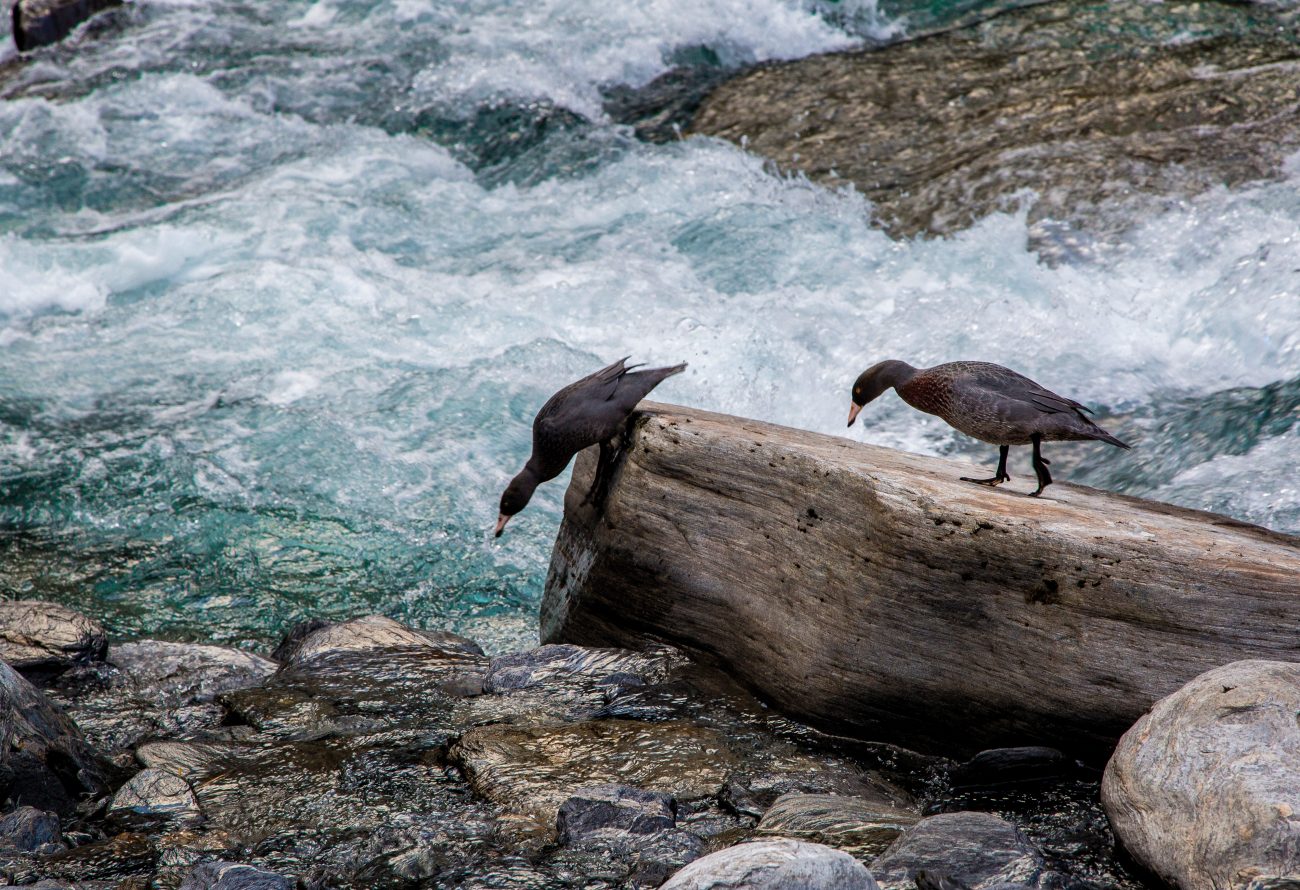
Morgan Gorge isn’t Manapouri. If the project is built, the modification will be reversible. The concession is for 49 years, after which the weir could theoretically be removed and the tunnel closed.
Then again, maybe Morgan Gorge is Manapouri—the best of the best, in its own way, the ne plus ultra of scenic grandeur and whitewater power, and a place that shouldn’t be tampered with. I can’t forget the moment of edging out on the mossy rock slab to confront its presence. Māori use the words ihi and wehi to describe the psychic force and awestruck response of an encounter with nature’s raw essence. Morgan Gorge has those qualities in full measure. Is this, then, a place to be exploited or revered?
The recreational community, in particular, argues that just knowing that such places remain intact in this country affirms something fundamental in our cultural identity, and that they should not easily be set aside.
















